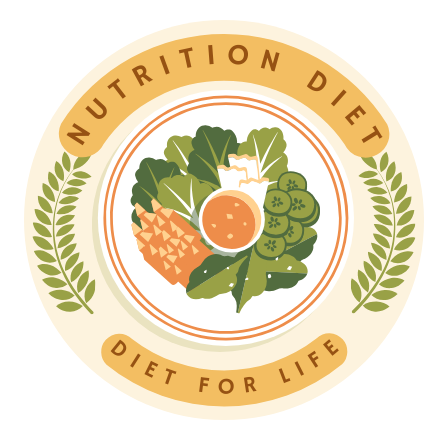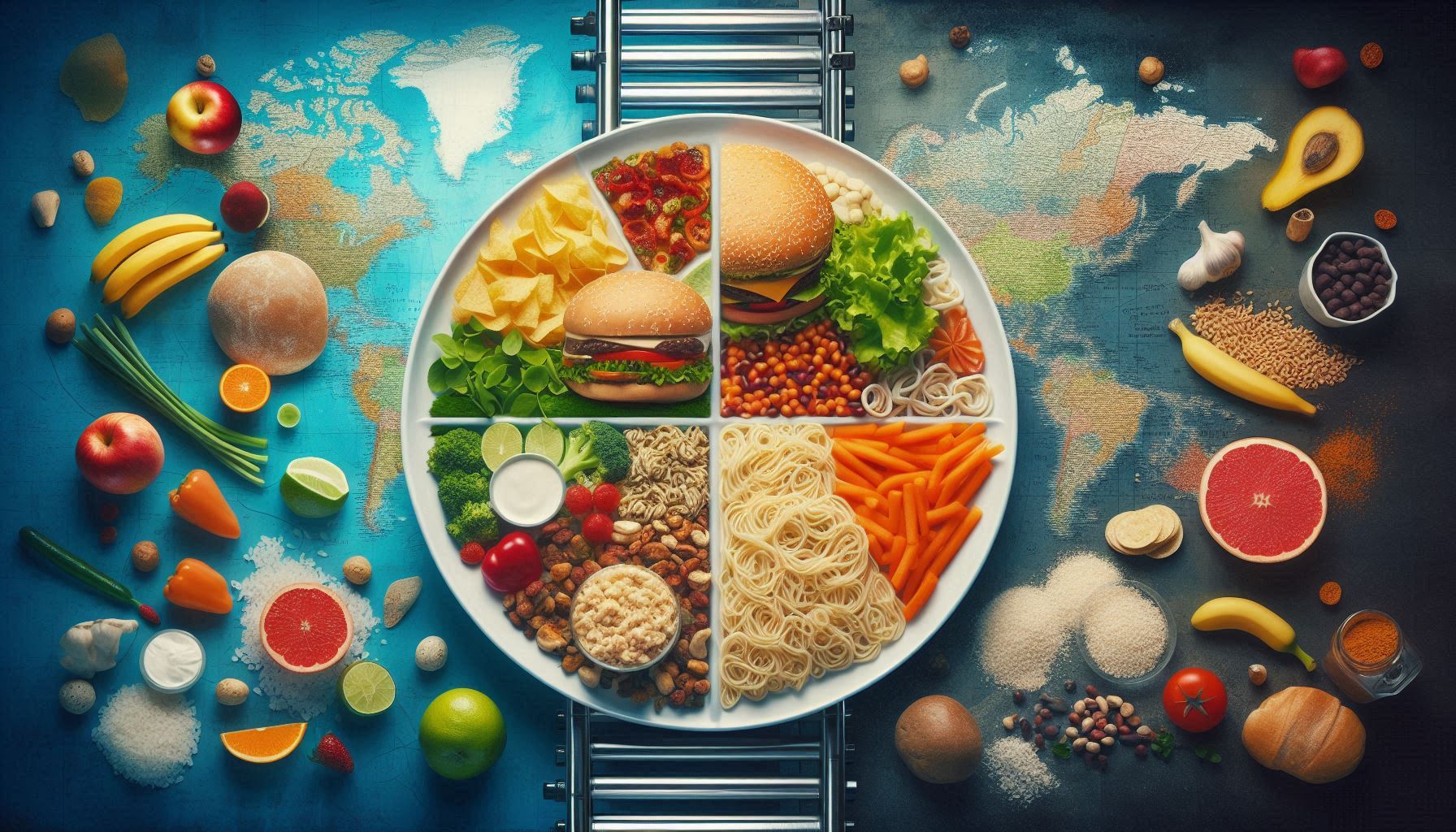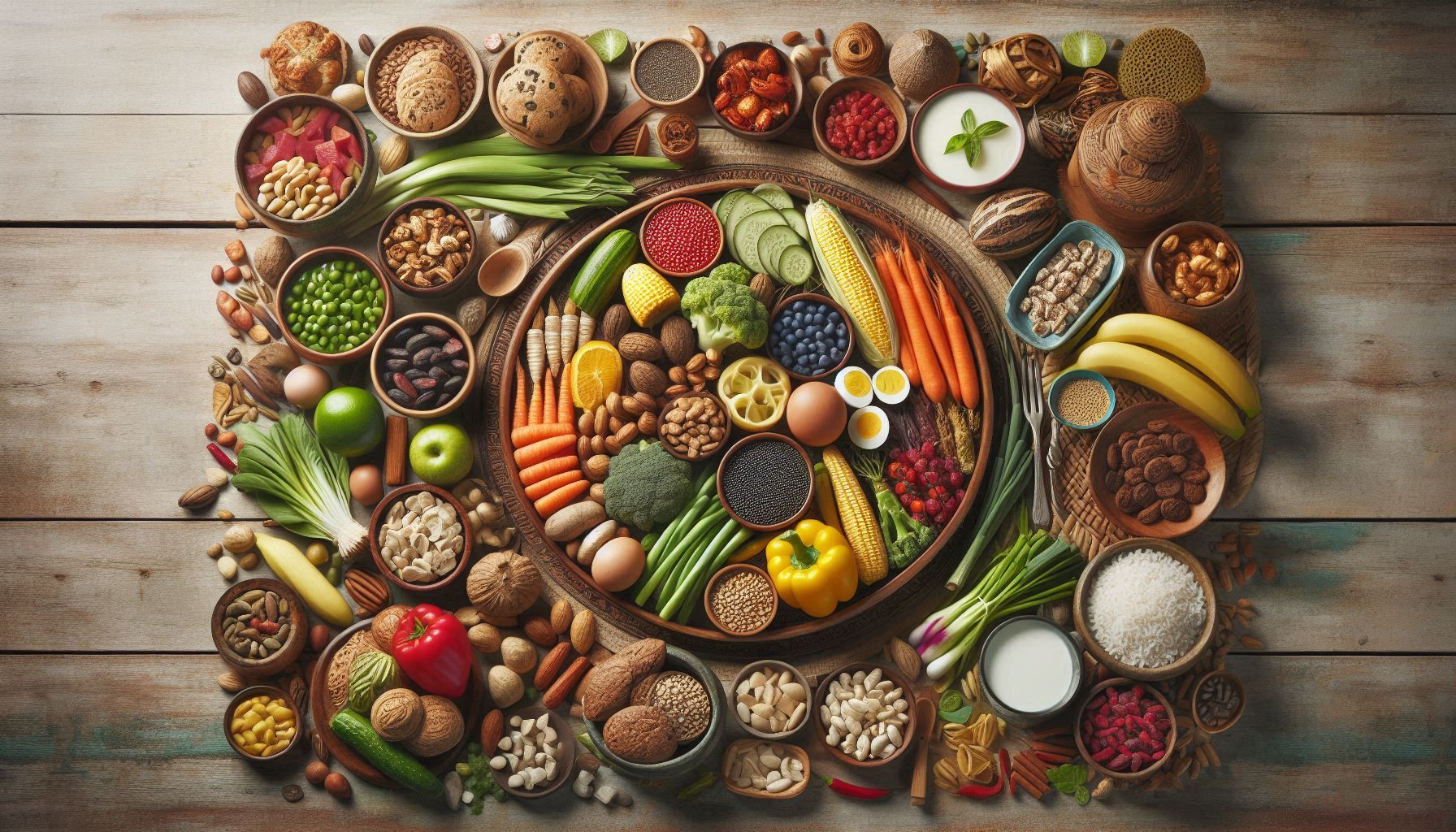In the 21st century, globalization has reshaped nearly every aspect of daily life—from how we communicate and travel to how we eat. One of the most overlooked yet profound effects of globalization is its impact on our diets. While the ability to access food from every corner of the planet may seem like progress, there’s a growing awareness that globalized diets often come at a cost: to our health, environment, culture, and economy. In contrast, local food systems are emerging as a healthier and more sustainable alternative.
This article explores the dark side of globalized diets and why turning to local foods may be the key to a healthier lifestyle and a more resilient planet.
What Are Globalized Diets?
Globalized diets refer to the standardization of eating patterns worldwide, often driven by multinational food corporations and the homogenization of taste. In this model, processed and packaged foods such as burgers, soda, white bread, instant noodles, fried snacks, and sugary cereals dominate store shelves from Tokyo to Toronto.
Thanks to international trade, fast-food chains, and aggressive marketing, dietary staples are no longer region-specific. For instance, pizza, soft drinks, and fried chicken are now as common in Nairobi and New Delhi as they are in New York. But this global spread of food products has led to the displacement of traditional, nutrient-rich diets based on local agriculture.
The Health Toll of a Global Diet
Globalized diets are often high in:
- Saturated fats
- Refined sugars
- Highly processed ingredients
- Artificial preservatives and additives
- Excess sodium
The consequences? A dramatic rise in chronic, non-communicable diseases.
a. Rise in Obesity and Diabetes
Countries that previously had low obesity rates, such as Mexico, India, and many nations in Africa, are now experiencing a surge in obesity and type 2 diabetes. This is largely attributed to the replacement of whole grains, legumes, and vegetables with calorie-dense, nutrient-poor convenience foods.
b. Nutrient Deficiencies
While globalized diets may offer an abundance of calories, they are often poor in essential nutrients like fiber, iron, and vitamins. Malnutrition can now mean being overweight yet nutrient-deficient—a paradox linked to ultra-processed food consumption.
c. Addiction to Processed Foods
Highly processed foods are designed to be hyper-palatable, using just the right combination of sugar, fat, and salt to trigger the brain’s reward centers. This can lead to food addiction and disordered eating habits, particularly in children.
Environmental Costs of a Global Food System
Feeding the world with globalized foods isn’t just unhealthy—it’s also unsustainable.
a. Carbon Footprint
Avocados flown from Mexico to Europe, apples shipped from New Zealand to the U.S., and bananas transported across continents all contribute to massive carbon emissions. A global food system is heavily dependent on fossil fuels for transportation, refrigeration, and storage.
b. Monoculture Farming
To meet global demand for certain crops—like corn, soy, and palm oil—many countries practice monoculture farming, which exhausts soil nutrients, promotes pesticide use, and leads to deforestation and biodiversity loss.
c. Water Usage
Globalized food production often means growing water-intensive crops in drought-prone regions, draining already scarce water supplies. For example, almonds grown for export in California consume billions of gallons of water annually.
Cultural Erosion and the Loss of Food Heritage
One of the most heartbreaking consequences of globalized diets is the loss of cultural identity. Food is more than sustenance—it is a reflection of history, geography, and tradition.
As global fast food and supermarket chains take over local markets, traditional recipes and culinary customs are fading. Indigenous ingredients are replaced with processed imports, and younger generations grow up without knowing their food heritage.
In places like the Philippines, Ghana, and Peru, traditional cooking techniques and local crops are being abandoned in favor of Western-style fast food. This leads to a homogenization of global cuisine, where French fries and cola replace fermented vegetables, native grains, and medicinal herbs.
Why Local Food Is a Healthier Alternative
Returning to local food systems offers a wide range of benefits—nutritional, environmental, cultural, and economic.
a. Higher Nutritional Value
Local food is often fresher and more nutrient-dense. It doesn’t sit in shipping containers or storage for weeks. Vegetables and fruits picked at peak ripeness retain more vitamins, antioxidants, and enzymes.
For example, a tomato grown in a local farm and consumed within days is likely to have a richer flavor and better nutrition than one harvested prematurely and ripened artificially during transport.
b. Supports Gut Health
Traditional diets often include fermented foods (like kimchee, kefir, and injure) and fiber-rich grains and legumes that support a healthy micro biome. Global diets, by contrast, are low in fiber and high in artificial ingredients that damage gut bacteria.
c. Reduces Chronic Disease Risk
Studies show that diets based on whole, minimally processed local foods—like the Mediterranean or Okinawan diets—are associated with lower rates of heart disease, cancer, and cognitive decline.
Local Food is better for the Planet
a. Lower Emissions
Food grown locally requires less transportation and refrigeration. This reduces greenhouse gas emissions and helps combat climate change.
b. Preserves Ecosystems
Local farming often supports biodiversity, sustainable agriculture, and soil regeneration. Traditional farming methods are more likely to incorporate crop rotation, composting, and natural pest control.
c. Less Packaging Waste
Local foods sold at farmers’ markets or co-ops typically use less plastic and packaging, cutting down on waste and pollution.
Economic and Community Benefits
Choosing local food isn’t just a dietary choice—it’s an investment in your community’s future. When consumers prioritize locally grown and produced food, they stimulate regional economies, support small-scale entrepreneurs, and create stronger, more self-reliant communities.
Job Creation and Economic Multiplier Effect
Local food systems support a broad network of jobs—not just on farms but also in processing, transportation, retail, and hospitality. A single small farm might employ a handful of people directly but also support dozens of related jobs in the supply chain.
When money is spent at local farmers’ markets, co-ops, or community-supported agriculture (CSA) programs, it tends to stay within the community. According to the American Farmland Trust, every dollar spent on local food generates twice as much economic activity within a region compared to spending the same amount at a national chain.
For example, in Vermont, local food sales contribute hundreds of millions annually to the state’s economy and help sustain rural livelihoods. Farm-to-table restaurants, local bakeries, microbreweries, and food trucks that source locally also benefit, creating a ripple effect throughout the economy.
Revitalizing Rural Communities
In many rural areas, industrial agriculture and globalization have led to job loss and community decline. Small farms were either bought out by large agribusinesses or forced out of operation. But with the growing interest in local food, some regions have seen resurgence in small-scale farming and entrepreneurship.
Local food hubs and farmers’ cooperatives have allowed small producers to access urban markets without needing to scale unsustainably. In the Appalachian region, for instance, local food initiatives have revitalized small towns by attracting new farmers and young entrepreneurs passionate about sustainable agriculture.
Food Sovereignty and Empowerment
“Food sovereignty” goes beyond food security; it refers to the right of communities to define their own agricultural systems and have control over how, where, and what food is produced and consumed. Local food systems give individuals and communities more control over their food sources, reducing dependence on volatile international markets or distant supply chains.
By supporting local producers and growing food in community gardens or cooperatives, neighborhoods can directly influence what food is available, how it is grown, and how profits are distributed. This is particularly vital in marginalized communities or food deserts, where access to fresh, affordable produce is often limited.
Resilience in Times of Crisis
Global food supply chains are highly vulnerable to disruptions—from pandemics and wars to climate change and economic shocks. The COVID-19 pandemic starkly revealed the fragility of our global food systems: empty supermarket shelves, shipping delays, and price spikes for basic goods became global concerns.
Communities with robust local food systems fared better. CSA programs surged in popularity, urban farms expanded, and backyard gardening flourished. Local producers were able to pivot quickly, providing flexible solutions and reducing reliance on global supply chains.
By investing in local food infrastructure—such as regional processing facilities, cold storage, and distribution networks—communities can become more self-reliant and better prepared for future shocks.
Civic Engagement and Social Cohesion
Farmers’ markets and local food events foster a sense of community. They offer spaces where people meet, share stories, learn about where their food comes from, and build relationships with growers. This engagement promotes trust, mutual support, and a greater sense of belonging.
Food is a powerful social connector. Initiatives like community kitchens, cooperative farms, and cultural food festivals don’t just feed people—they empower them to collaborate, celebrate local heritage, and find common ground.
How to Transition to a More Local Diet (Expanded)
Making the shift to a more local diet doesn’t mean giving up all imported foods or becoming self-sufficient overnight. It’s about making conscious choices—small, practical steps that add up over time to a healthier lifestyle and a more resilient food system.
Here are several actionable strategies and tips for transitioning to local eating in ways that are accessible, enjoyable, and sustainable:
1. Shop at Farmers’ Markets
Farmers’ markets are among the most direct ways to access local food. You’ll find seasonal produce, meats, eggs, dairy, honey, baked goods, and sometimes artisanal products like jams, cheeses, and condiments—all sourced directly from regional producers.
Benefits:
- Fresher, more flavorful food
- Direct interaction with growers (ask questions, learn about methods)
- Supports local jobs and keeps money in the local economy
Tip: Bring your own bags, go early for the best selection, and plan meals based on what’s available.
2. Join a CSA (Community Supported Agriculture)
CSA programs allow you to buy a “share” of a farm’s harvest in advance. In return, you receive a box of fresh produce (and sometimes eggs, meats, or flowers) each week throughout the growing season.
Advantages:
- Access to ultra-fresh, often organic food
- Exposure to new fruits and vegetables (encourages creativity in the kitchen)
- Builds a direct relationship with your farmer
Some CSAs even offer flexible payment plans or work-trade options to increase accessibility.
3. Cook More at Home Using Local Ingredients
Cooking is one of the most powerful ways to regain control over your diet. Using local ingredients means meals are not only fresher but also more aligned with the seasons and the region.
Ideas:
- Learn to preserve seasonal produce (pickling, fermenting, freezing)
- Try simple recipes with fewer, higher-quality ingredients
- Host seasonal potlucks or themed dinners with friends
Cooking with local food can turn meals into meaningful rituals that reconnect you with place and tradition.
4. Learn About Native Plants, Ingredients, and Cultural Dishes
Every region has its own unique food heritage—rooted in climate, geography, and culture. Reconnecting with these traditions can be an inspiring way to eat locally and diversify your meals.
How to start:
- Research traditional dishes from your region or ancestry
- Visit museums, libraries, or cultural centers to explore food history
- Learn from elders or community leaders who hold culinary knowledge
Reviving indigenous and heirloom crops also help preserve biodiversity and honor cultural heritage.
5. Grow Your Own Food (Even Just a Little)
You don’t need to own land to grow food. Even a windowsill herb garden or balcony tomato plant can reconnect you to the rhythms of nature and deepen your appreciation for what goes into producing a meal.
Urban gardening ideas:
- Vertical gardens for small spaces
- Raised beds in backyards or community gardens
- Micro greens and sprouts indoors
Gardening also builds skills, resilience, and mindfulness. It’s therapeutic, educational, and empowering—especially for children.
6. Support Local Food Businesses
Patronize restaurants, cafes, bakeries, and food producers that source locally. Many of these businesses proudly display where their ingredients come from or participate in farm-to-table networks.
Look for:
- Menus that highlight local farms
- Local food co-ops and independent grocers
- Artisanal producers of jams, pickles, cheeses, and fermented goods
Your dollars help these businesses grow and encourage others to adopt similar sourcing practices.
7. Educate Yourself and Others
Awareness is the first step toward meaningful change. Educate yourself and share what you learn with friends, family, and coworkers.
Resources:
- Books like The Omnivore’s Dilemma by Michael Pollen or Animal, Vegetable, Miracle by Barbara Kingsolver
- Documentaries like Kiss the Ground, Food, Inc., and The Biggest Little Farm
- Podcasts such as The Urban Farm, Sustainable World Radio, or The Food Chain
Consider starting or joining a local food movement, policy group, or urban agriculture initiative in your area.
8. Make Local Eating a Long-Term Habit, Not a Short-Term Trend
The key to a sustainable local food lifestyle is consistency and intention. Don’t worry about being perfect—just start where you are and build gradually.
Suggestions:
- Set a goal (e.g., source 50% of your produce locally)
- Track your local food spending each month
- Celebrate seasonal milestones with special meals
As habits form, you’ll likely find that local food tastes better, feels better, and connects you more deeply with your community and the natural world.
Conclusion
The rise of globalized diets has undeniably brought a level of convenience, variety, and accessibility that previous generations could scarcely imagine. From instant noodles to fast-food burgers and year-round tropical fruits, modern consumers can now eat almost anything, anytime, from anywhere in the world. But this seemingly limitless abundance comes at a steep price—one that is quietly reshaping our health, degrading our environment, and eroding centuries of culinary and cultural heritage.
What we’re gaining in convenience, we’re losing in quality. What we save in time, we pay for with rising rates of chronic illness. What we gain in availability, we sacrifice in sustainability. The global food system—largely controlled by multinational corporations—is increasingly built around ultra-processed products, industrial agriculture, and long supply chains that prioritize profits over people and the planet.
Embracing local food is not a rejection of globalization—it’s a rebalancing of our priorities. It’s an act of resistance against the homogenization of taste, the overreliance on chemical-laden farming, and the cultural dilution that comes with abandoning traditional foods. Local eating means reconnecting with where our food comes from and the people who produce it. It means celebrating seasonality, valuing biodiversity, and preserving the wisdom of ancestral food knowledge.
When we buy from local farmers, cook with indigenous ingredients, and preserve our regional dishes, we not only feed our bodies with fresher, more nutrient-dense food—we also invest in the resilience of our communities. We support small businesses, protect regional ecosystems, reduce greenhouse gas emissions, and strengthen food sovereignty. We begin to close the gap between production and consumption, making our food systems more transparent, ethical, and sustainable.
Moreover, local food fosters a deeper emotional and cultural connection to what we eat. There’s a story behind every heirloom tomato, every handmade loaf of bread, every wild mushroom harvested from a local forest. These foods are not just nourishment—they are heritage. They are expressions of place, history, and identity that can’t be replicated by industrialized, globally standardized products.
The path to a healthier future—physically, environmentally, and culturally—begins not on a factory line, but in our kitchens, gardens, and local markets. The solution too many of today’s food-related crises may not lie in the next imported super food or mass-marketed meal replacement. Instead, it may begin with what we grow, cook, and share at home. The future of food is local, and it’s time we returned to our roots—not out of nostalgia, but out of necessity.
SOURCES
World Health Organization (WHO) – Global report on no communicable diseases and dietary shifts (2024)
Food and Agriculture Organization (FAO) – “The State of Food and Agriculture” reports (2024)
Harvard T.H. Chan School of Public Health – Research on processed foods and chronic disease (2023)
Centers for Disease Control and Prevention (CDC) – Obesity and diabetes statistics (2024)
The Lancet – Global Burden of Disease Study (2024)
United Nations Environment Programmed (UNEP) – Environmental impact of global agriculture (2023)
EAT-Lancet Commission – Planetary health diet and sustainable food systems (2024)
International Food Policy Research Institute (IFPRI) – Global food trade and development (2024)
National Institute of Health (NIH) – Additives and metabolic disorder research (2023)
Michael Pollen – In Defense of Food and newer interviews/articles (2023)
Slow Food International – Advocacy on food culture and biodiversity (2024)
Journal of the Academy of Nutrition and Dietetics – Research on local vs. global diets (2024)
Nature Food – Journal on food systems and sustainability (2024)
Environmental Working Group (EWG) – Reports on farming, pesticides, and water use (2024)
Union of Concerned Scientists (UCS) – Agricultural impact reports (2023)
World Resources Institute (WRI) – Food system emissions and policy briefings (2024)
PLOS ONE – Studies on dietary globalization and urban health (2023)
American Journal of Clinical Nutrition – Comparative dietary research (2024)
National Geographic – “The Future of Food” – Multimedia and articles on global diets (2024)
UNESCO – Traditional food ways as intangible cultural heritage (2024)
Global Alliance for the Future of Food – Food system transformation reports (2024)
Local Harvest – CSA/local food systems database and blog (2024)
Blue Zones Project – Research on traditional longevity diets (2024)
HISTORY
Current Version
June 12, 2025
Written By
ASIFA




